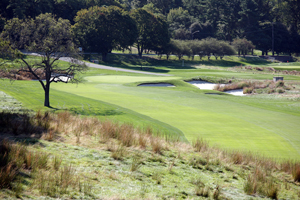US Open golf blog: Unleash the Beast
In 2002 Bethpage Black proved to be one of the toughest US Open courses ever. The championship is back there this year, but Iain Carter expects it to be a fairer challenge.

In the last seven years the Major have gone full circle. During what may one day be referred to as the ‘Tiger-proofing era’ the Bethpage Black Course, the venue for this year’s US Open, provides the perfect illustration of how the game has at last come to terms with modern golf.
This is the period when courses have been fighting back against the march of technology. In 2002 when Bethpage first staged America’s national championship it had tees so far back fairways were out of range. Size was everything and the only answer the game had could be summed up with the acronym: LONG. ‘Lengthen’ holes, ‘Ostracise’ fans with ‘Narrow’ fairways and by ‘Growing’ rough. It all got a little bit silly...
While modern clubs and balls made the game undoubtedly easier and therefore more fun for us hackers, we were finding it less appealing to watch. Too many classic courses were rendered obsolete and there seemed less scope for creativity.
The ultra-long Bethpage of 2002 appeared to sum up the era. Tiger Woods was the only man to break par and it was the New York crowds (with their ‘Be Nice to Monty’ tee shirts and ready wit) who saved the day. Not that there was much surprise that the USGA had provided such a test for the world’s best players. Par should be the winning score in their eyes and they seek to provide the sternest demands of any golfing body in the world.
As a result the good men and women of the United States Golf Association are often in the firing line. Critics feel they overstep the mark.
The year after Bethpage the US Open moved to the Chicago suburbs and the Olympia Fields Club. It staged one of the dullest Majors ever, won by Jim Furyk.
I was lucky enough to come out of a ballot to play the course the day after Furyk had ground his way to victory. Actually, scrub the ‘lucky’ from the previous sentence. We lasted nine holes. It was the most miserable form of golf I have ever encountered and the weather was perfect.
Get the Golf Monthly Newsletter
Subscribe to the Golf Monthly newsletter to stay up to date with all the latest tour news, equipment news, reviews, head-to-heads and buyer’s guides from our team of experienced experts.
The following year the USGA had a far more attractive piece of golfing real estate to mess up and at the glorious Shinnecock Hills, that’s exactly what they did. The greens were harder and faster than the runway at JFK – it was an unfunny joke.
But this is where the circle began to turn. Pinehurst Number Two in 2005, with its upturned saucer greens, was set up slightly more sympathetically and we had a thriller as Michael Campbell held off Woods to triumph.
At Winged Foot in 2006 we needed those ‘Be Nice to Monty’ tee shirts to offer comfort as the big man blew his best chance of a Major. But remember the course and the test. It was brutal, yes, but even with bumpy greens it was fair.
The trend continued through Oakmont in ’07 and especially at Torrey Pines last year.
Throughout this period the other Majors have struggled with the similar issues. Augusta lost its magic, Open Championship courses have been stretched and the USPGA – always deemed the fairest Major of the lot – completely lost the plot with the ludicrous set-up for last year’s Championship.
The Masters seems to have learned its lesson with the accent on fairness at the first Major of this year and it reaped the rewards with a thrilling tournament. I would expect the USPGA to do the same at Hazeltine in August and The R&A are too sensible to do anything silly with a gem like Turnberry.
As for the next Major, well I’m confident the USGA will look after Bethpage Black. It is a beast that will be as tough as ever. But given the current trend, expect it to be fair as well. The short stuff on the 10th might even be within range from the tee!
-
 Volvo China Open 2025 Picks, Odds And Predictions
Volvo China Open 2025 Picks, Odds And PredictionsFollowing a break for The Masters, the DP World Tour returns for the final two weeks of its Asian Swing and the Volvo China Open is the penultimate event
By Jonny Leighfield
-
 Rory McIlroy's Sports Psychologist Explains Why He 'Didn't Talk' To Bryson DeChambeau In Masters Final Round
Rory McIlroy's Sports Psychologist Explains Why He 'Didn't Talk' To Bryson DeChambeau In Masters Final RoundDeChambeau raised eyebrows at Augusta National when claiming that McIlroy wouldn't engage in conversation during the final round of The Masters
By Jonny Leighfield